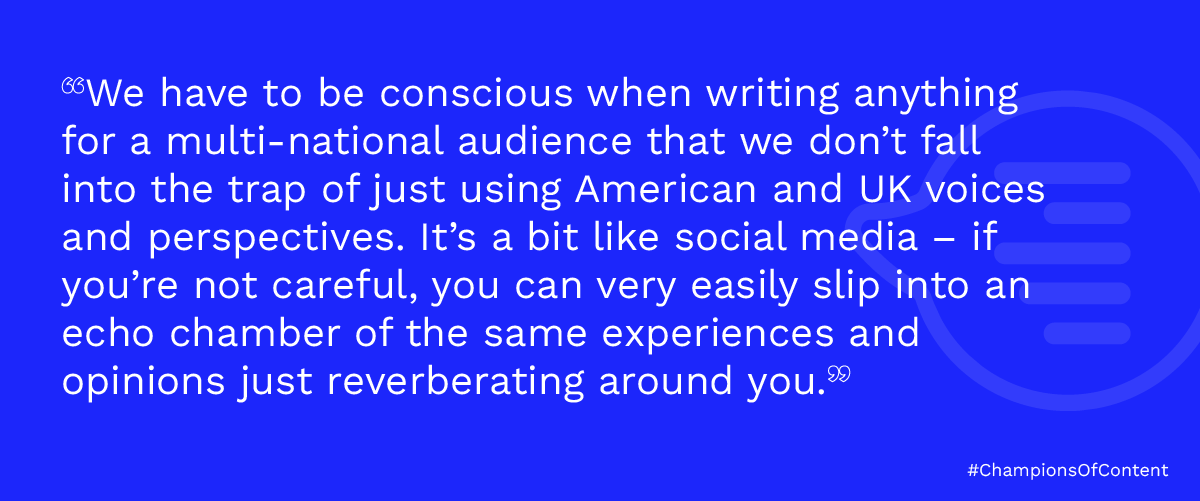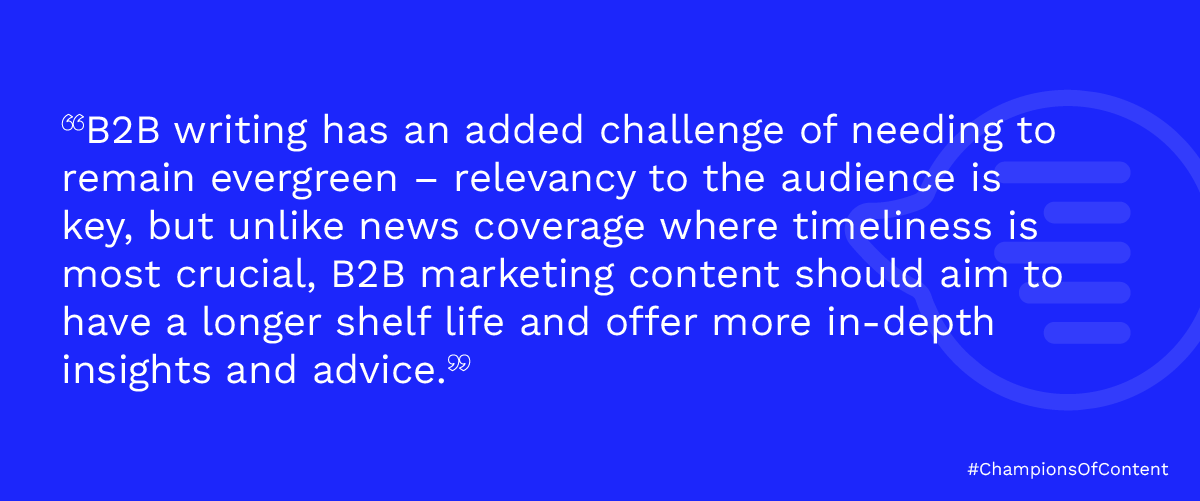Champions of Content – Q&A with Oliver Pickup: Award-winning journalist, writer, and speaker
Welcome to the first in our new series: Champions of Content.
Content is integral to the way brands are understood and seen by their audiences, but developing content for different audiences, on different channels and even in different languages can be very complicated to get right.
In Champions of Content, we’ll be speaking to passionate content creators we admire including marketers, journalists, writers, podcasters, and speakers about their experiences and sharing the wisdom to help others on their own content journey – whether your first putting pen to paper or looking to level up your content strategy.
Oliver Pickup is an award-winning writer, editor, speaker, content strategist and illustrator. His work has been featured in the Guardian, the FT and The Times (to name just a few), and he now frequently writes for a combination of corporate clients and media outlets, as well as being recognised as a thought leader in technology and the future of work.
In this conversation, we consider what a pertinent moment it is to be thinking about content, how AI tools might empower journalists in a budget-limited and clicks-focussed world, and why great content is often more about good thinkers than good writers.
Please can you start by telling us about your own career journey as it relates to content and what role content plays in your work today?
I started my career after doing a postgraduate course in magazine journalism. Back then I wanted to be a sports journalist and wrote to a few of the writers I admired at the time – and miraculously, in fountain pen, a few wrote back.
They suggested going to a sports agency, so that’s where I started out. And it was quite stressful – going to various sports matches and needing to file a certain number of words on the final whistle to various newspapers and outlets. This was very early internet days too so while it seems completely alien now, I’d have to ring up and file my report by dictating it.
But I realised quite late in my sports journalism career that it was the humans, and the stories of superhuman feats and emotions, that I found so compelling. Which is what is so interesting considering the ChatGPT explosion we’ve seen recently. Can a generative AI machine make good content? Yes, it can, but is it human? These questions echo a great response Nick Cave gave to a ChatGPT that produced lyrics ‘in his style’ and that’s that AI can’t ever really understand human suffering and emotion.
For me, emotion is what elevates great content. Today my work is more focused in the technology and business worlds, but the importance of human stories has carried through. In addition to writing, I also moderate virtual roundtables for outlets like Raconteur and do other speaking work like podcasts. These are exciting, and I like to stay open to the potential new forms of content offer.
Whose content – brands or individuals – do you admire most and why?
The New York Times is always pushing content boundaries. A piece that struck me was Snowfall in 2012, a multi-media article about an avalanche that offers a mind blowing, suitably all-consuming, coverage of an avalanche.
The piece has different breakaways throughout the article that are hugely effective – a 3D visual you can spin around, audio interviews of the people involved, graphics and figures… That was over ten years ago, and at the time I remember thinking, ‘this is the future of content and reporting’.
But sadly, no one has really taken that on. There are immense pressures now on mainstream media to monetize and increase advertising spends and clicks, which I think might explain why we haven’t seen more Snowfall-type pieces.
That said, now we have tools like ChatGPT and lots of other AI foundational generational models that are creating this kind of immersive content – it’s exciting to think we might start to see more of this kind of journalism. AI has potential to give journalists back more time to think and bring about more balanced, nuanced and creative content and reporting.
We all want our content to stand out. What do you think are the main ingredients that make one piece of content stand out above another?
Nuance and balance – in an age of clickbait noise – stand out to me, and an important way I think we achieve this kind of content is preparation.
Something I’ve heard that really resonates with me is that often, people aren’t looking for the good writers, they’re looking for the good thinkers. I might not be the best writer, but I put an awful lot of effort into preparing for a feature or an interview, speaking to multiple sources to make for more balanced, interesting stories. I may only use 10% in the final piece, but that other 90% isn’t discarded – it informs the piece in other ways and informs future pieces.
The power of great stats can’t be underestimated either, nor can content that isn’t afraid to go against the grain or share a strong opinion.

What are some of the challenges you face when producing content for different channels and audiences, and how do you deal with these? Here at Tyto, we often navigate the complexity of developing content for different audiences in different countries.
We must be conscious when writing anything for a multi-national audience that we don’t fall into the trap of just using American and UK voices and perspectives. It’s a bit like social media – if you’re not careful you can slip into an echo chamber of the same experiences and opinions just reverberating around you.
On a global B2B project I work on called Art of Smart, we’ve made a concerted effort this year to engage writers in the Nordics, Africa and Australasia to better understand and showcase their unique challenges and thoughts, so it resonates more widely.

There’s certainly challenges in writing for different channels too – my journalist mindset is quite different to if I’m ghost-writing for c-suite leaders, for example. B2B writing also has an added challenge of needing to remain evergreen – relevancy to the audience is key, but unlike news coverage where timeliness is most crucial, B2B marketing content should aim to have a longer shelf life and offer more in-depth insights and advice.
Are you excited by AI and ChatGPT, and if so, where do you see the greatest potential to harness is in the development of content, now or in the future?
From a content perspective, I think it’s absolutely thrilling that we have these generative AI models that can create amazing images and written content at very low cost. I spoke to a Stanford professor just last week who said we’re expecting the next generation of GPT within a month, which is going to be a whole other step change too.
While the speed of these advancements is exciting, the ethics and idea we’re perhaps not fully grasping the full scale of AI’s power is worrying. But ultimately, I think we need to embrace it.
Another interesting consideration I’ve had in researching this is how we flip our mindset from “robots and AI are going to come and replace us” to instead thinking “how can they complement us?” It’s far less interesting to think about automating human jobs and tasks than it is to think how AI can plug the gaps humans can’t do and elevate our work.

For brands or individuals planning to level up their content in 2023, what would be your top three bits of advice for how they can increase the impact of their content? What should they be thinking about and looking at? What are you thinking about?
Brand presence on social is important. Even if – like me – you’re not the biggest user of social media or try to limit your use, having a presence there creates authority and offers an invaluable channel to amplify your content.
Authenticity is key. Content that’s balanced, thoughtful, backed in stats and data. This balance and the human emotion element are what makes the best content stand apart and really resonate with readers beyond securing clicks.
Finally, I’d say originality. Content that is a bit unusual or that explores hidden corners that perhaps have been neglected or we don’t shine a light on enough. In my beat of ‘the future of work’ a good example of this is coverage of deskless and frontline workers – which are around 80% of our workforce but covered comparatively less than white collar workforce in the HR and work-focussed media.



